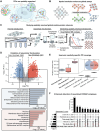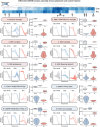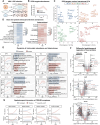Sequestration of ribosome biogenesis factors in HSV-1 nuclear aggregates revealed by spatially resolved thermal profiling
- PMID: 40577456
- PMCID: PMC12204162
- DOI: 10.1126/sciadv.adw6814
Sequestration of ribosome biogenesis factors in HSV-1 nuclear aggregates revealed by spatially resolved thermal profiling
Abstract
Viruses exploit host cell reliance on compartmentalization to facilitate their replication. Herpes simplex virus type 1 (HSV-1) modulates the subcellular localization of host proteins to suppress immune activation, license viral gene expression, and achieve translational shutoff. To spatially resolve dynamic protein-protein interaction (PPI) networks during infection with an immunostimulatory HSV-1 strain, we integrated nuclear/cytoplasmic fractionation with thermal proximity coaggregation analysis (N/C-TPCA). The resulting expanded depth and spatial resolution of PPIs charted compartment-specific assemblies of protein complexes throughout infection. We find that a broader suite of host chaperones than previously anticipated exhibits nuclear recruitment to form condensates known as virus-induced chaperone-enriched (VICE) domains. Monitoring protein and RNA constituents and ribosome activity, we establish that VICE domains sequester ribosome biogenesis factors from ribosomal RNA, accompanying a cell-wide defect in ribosome supply. These findings highlight infection-driven VICE domains as nodes of translational remodeling and demonstrate the utility of N/C-TPCA to study dynamic biological contexts.
Figures






References
-
- Monier K., Armas J. C., Etteldorf S., Ghazal P., Sullivan K. F., Annexation of the interchromosomal space during viral infection. Nat. Cell Biol. 2, 661–665 (2000). - PubMed
-
- Chelbi-Alix M. K., de Thé H., Herpes virus induced proteasome-dependent degradation of the nuclear bodies-associated PML and Sp100 proteins. Oncogene 18, 935–941 (1999). - PubMed
MeSH terms
Substances
Grants and funding
LinkOut - more resources
Full Text Sources
Medical

